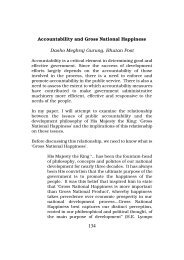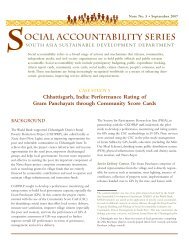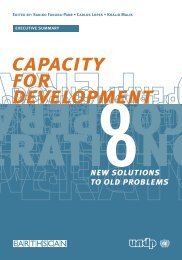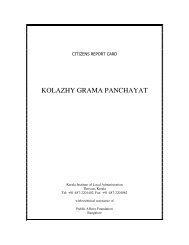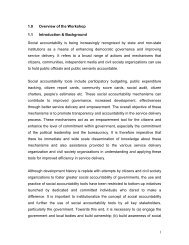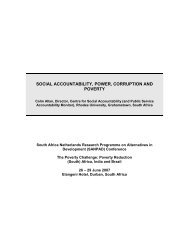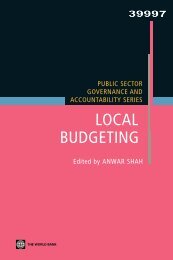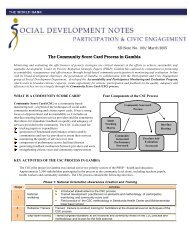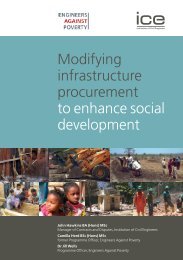Enabling Environment for Social Accountability in ... - SASANet
Enabling Environment for Social Accountability in ... - SASANet
Enabling Environment for Social Accountability in ... - SASANet
Create successful ePaper yourself
Turn your PDF publications into a flip-book with our unique Google optimized e-Paper software.
Respondents were equally divided on whether participation <strong>in</strong> a local council meet<strong>in</strong>g would be effective,<br />
somewhat effective, or slightly effective (annex 6, Question LL). The results of the survey are expla<strong>in</strong>ed partly by<br />
the UB-bias of NGOs <strong>in</strong> Mongolia and the likelihood that national rather than local officials were targeted.<br />
Additionally, the centralization of public policy and the budget process have weakened <strong>in</strong>centives <strong>for</strong> citizens and<br />
CSOs to negotiate with relatively anemic local governmental <strong>in</strong>stitutions that are upwardly accountable (F<strong>in</strong>d<strong>in</strong>g<br />
3.4.2).<br />
A strik<strong>in</strong>g example is weak <strong>in</strong>volvement <strong>in</strong> school councils or local communities <strong>in</strong> general (see annex 4, F<strong>in</strong>d<strong>in</strong>g<br />
EDU 6). When the Ongi River Movement tried to ga<strong>in</strong> <strong>in</strong><strong>for</strong>mation that would make m<strong>in</strong><strong>in</strong>g companies and<br />
public officials accountable, the lack of downward accountability thwarted its ef<strong>for</strong>ts <strong>for</strong> en<strong>for</strong>cement of laws on<br />
environmental protection (see annex 3, F<strong>in</strong>d<strong>in</strong>g ONGI 6).<br />
Many stakeholders blame the Public Sector Management and F<strong>in</strong>ance Law <strong>for</strong> the lack of downward<br />
accountability. The PSMFL has shown positive results <strong>in</strong> several areas, such as timely budget transfers, control of<br />
wage arrears, and overall fiscal discipl<strong>in</strong>e. However, the law has also removed most revenue-rais<strong>in</strong>g authority<br />
from local governments, and limited their role <strong>in</strong> service delivery. Nor have any compensat<strong>in</strong>g arrangements been<br />
made <strong>for</strong> citizen engagement <strong>in</strong> local budget processes and expenditure track<strong>in</strong>g (see box 3.4.2).<br />
Box 3.4.2 Decentralization: Structural and Practical Impediments to <strong>Social</strong> <strong>Accountability</strong><br />
An important constra<strong>in</strong>t on social accountability <strong>in</strong> Mongolia is the <strong>in</strong>consistency between the centralized <strong>in</strong>tergovernmental<br />
fiscal transfer system and the relatively decentralized political structures. The centralized fiscal management system has<br />
achieved macroeconomic stability, controlled wage arrears, and enabled timely budgetary transfers to local governments<br />
(Mongolia’s Regional Development Note 2005).<br />
The <strong>in</strong>tergovernmental fiscal mechanism has its legal basis <strong>in</strong> the General Budget Law, which regulates revenue relations,<br />
and the 2002 Public Sector Management and F<strong>in</strong>ance Law, which regulates expenditure responsibilities. The <strong>in</strong>tention of<br />
the PSMFL is to <strong>in</strong>crease the accountability and effectiveness of public sector <strong>in</strong>stitutions at all levels while respect<strong>in</strong>g the<br />
need <strong>for</strong> fiscal restra<strong>in</strong>t and susta<strong>in</strong>ability. Un<strong>for</strong>tunately, by centraliz<strong>in</strong>g fiscal powers, the law effectively weakened local<br />
governments, severely limit<strong>in</strong>g their tax-rais<strong>in</strong>g powers and responsibilities <strong>for</strong> service delivery. Indeed, the current<br />
governance system “fragments responsibilities of local governments and control over resources, result<strong>in</strong>g <strong>in</strong> weaken<strong>in</strong>g of<br />
accountability and service delivery <strong>for</strong> public resources” (Mongolia’s Regional Development Note 2005:2).<br />
The PSMFL does not make provision <strong>for</strong> the participation of soum khurals or ord<strong>in</strong>ary citizens <strong>in</strong> budget processes. At<br />
present their roles are ad hoc and varied <strong>in</strong> practice (World Bank 2004d). Dur<strong>in</strong>g <strong>in</strong>terviews and focus groups, many<br />
stakeholders concurred that the PSMFL had not enhanced downward accountability of public sector <strong>in</strong>stitutions, but rather<br />
limited the autonomy of local officials and thereby strengthened their upward accountability. These f<strong>in</strong>d<strong>in</strong>gs are supported<br />
by the work of Rob<strong>in</strong> Mearns, Decentralization, Rural Livelihoods and Pasture-Land Management <strong>in</strong> Post-<strong>Social</strong>ist<br />
Mongolia. Mearns notes that while the PSMFL requires all public agencies to review and submit reports annually to the<br />
M<strong>in</strong>istry of F<strong>in</strong>ance and Economics, there are no provisions hold<strong>in</strong>g these agencies accountable to local citizens.<br />
Consequently, under the current system, the governors “have little downward accountability to their local constituencies.”<br />
The PSMFL also centralized most taxes previously shared with local governments, and local governments have few<br />
powers to <strong>in</strong>stitute new taxes. Such restrictions <strong>in</strong> revenue-collection powers may dim<strong>in</strong>ish <strong>in</strong>centives <strong>for</strong> governors to be<br />
downwardly accountable, as well as <strong>for</strong> citizens, who do not pay taxes to local governments, to demand accountability from<br />
local officials.<br />
Local governors have limited decision-mak<strong>in</strong>g powers <strong>in</strong> each sector. Although aimag budgets reflect spend<strong>in</strong>g on<br />
education and health, the funds actually flow directly from the central government to respective schools and hospitals.<br />
Hence local governments do not have any control over these funds. As one soum governor noted, these “limitations on<br />
budget spend<strong>in</strong>g on the part of the governor also constra<strong>in</strong> citizen <strong>in</strong>fluence on the budget-allocation process,” as l<strong>in</strong>e-item<br />
provisions leave little room <strong>for</strong> local decision mak<strong>in</strong>g. Indeed, as Mearns argues, <strong>in</strong> this environment there is little <strong>in</strong>centive<br />
<strong>for</strong> local populations to use their elected representatives as channels <strong>for</strong> articulat<strong>in</strong>g concerns and mak<strong>in</strong>g claims (Mearns<br />
2002:138).




